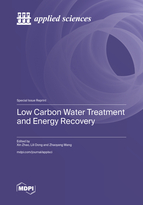Low Carbon Water Treatment and Energy Recovery
A special issue of Applied Sciences (ISSN 2076-3417). This special issue belongs to the section "Environmental Sciences".
Deadline for manuscript submissions: closed (30 December 2022) | Viewed by 25239
Special Issue Editors
Interests: wastes anaerobic fermentation; bioenergy recovery, biological processes; wastes conversion and biological treatment; wastewater treatment
Special Issues, Collections and Topics in MDPI journals
Interests: bio-H2 production; anaerobic digestion; lignocellulosic biomass pretreatment; bioenergy recovery; microbial ecology
Special Issues, Collections and Topics in MDPI journals
Interests: municipal wastewater treatment and reuse; industrial wastewater treatment; micropollution drinking water treatment
Special Issues, Collections and Topics in MDPI journals
Special Issue Information
Dear Colleagues,
Climate change led by excess carbon dioxide emissions is a global challenge. For the water industry, the water treatment process is responsible for the amounts of different carbon emissions. The water industry makes global warming worse, so innovative wastewater treatment that exhausts less or no carbon dioxide is significant. Recently, carbon neutrality has become a hot topic for water treatment all over the world.
To reduce carbon emissions from water treatment, technological and scientific advances will be required, such as biomass production to reduce CO2 emissions, use of bubble-less gas mass transfer bioreactors, reduced aeration with greater microbial processes, high-efficiency pumps and blowers, low-pressure self-cleaning free membranes, and the use of solar power systems and bioelectrical systems in wastewater treatment. Our present technology for water and wastewater treatment offers enormous scope for improvement.
Based on this background, this Special Issue aims to assemble the latest advancements in innovative technologies for low carbon water treatment and energy recovery. Both full-length research papers and review articles are welcome.
Dr. Xin Zhao
Dr. Lili Dong
Dr. Zhaoyang Wang
Guest Editors
Manuscript Submission Information
Manuscripts should be submitted online at www.mdpi.com by registering and logging in to this website. Once you are registered, click here to go to the submission form. Manuscripts can be submitted until the deadline. All submissions that pass pre-check are peer-reviewed. Accepted papers will be published continuously in the journal (as soon as accepted) and will be listed together on the special issue website. Research articles, review articles as well as short communications are invited. For planned papers, a title and short abstract (about 100 words) can be sent to the Editorial Office for announcement on this website.
Submitted manuscripts should not have been published previously, nor be under consideration for publication elsewhere (except conference proceedings papers). All manuscripts are thoroughly refereed through a single-blind peer-review process. A guide for authors and other relevant information for submission of manuscripts is available on the Instructions for Authors page. Applied Sciences is an international peer-reviewed open access semimonthly journal published by MDPI.
Please visit the Instructions for Authors page before submitting a manuscript. The Article Processing Charge (APC) for publication in this open access journal is 2400 CHF (Swiss Francs). Submitted papers should be well formatted and use good English. Authors may use MDPI's English editing service prior to publication or during author revisions.
Keywords
- low carbon
- carbon neutrality
- water treatment
- wastewater treatment
- energy recovery
- anaerobic digestion
- bioelectrical system
- biogas
- water reuse
- micropollution








